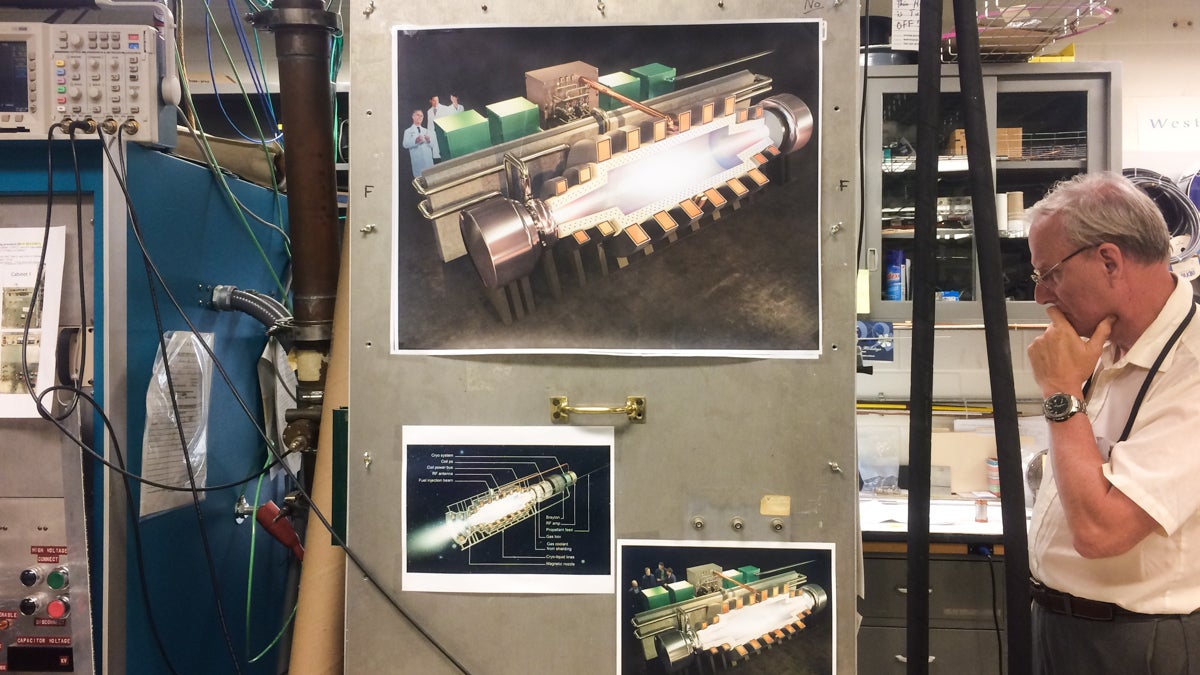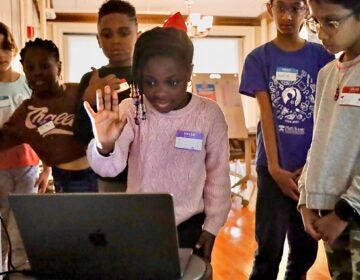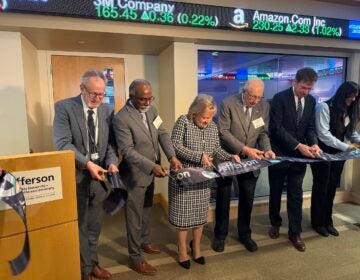Inside the NASA program that makes science fiction technology real
Listen 9:22
Researchers at the Princeton Plasma Physics Lab in New Jersey put up a picture of the nuclear fusion drive they’re building in their workspace. (Alan Yu/WHYY)
Physicists and engineers in New Jersey are working on a power source that can take humans far out into our solar system.
We have long dreamed of going to space, but some people, like SpaceX founder Elon Musk, say that we have to go to space, because there will be some doomsday event on earth, so we should become a space-faring civilization.
“I really don’t have any other motivation for personally accumulating assets, except to be able to make the biggest contribution I can to making life multi-planetary,” he said last September.
He has a plan for getting us to Mars, but right now, it takes us about eight months to send robots to Mars. If you want to send humans beyond our solar system, maybe to one of those potentially habitable exoplanets, we need to think about fuel.
If we took a rocket, we’d have to refuel because it doesn’t make sense to carry all that fuel up as extra weight.
NASA’s New Horizons probe that got to Pluto used nuclear fuel. But, if this was the type of fuel we used, there wouldn’t be a lot of power on the spaceship.
Star Wars created a hyperdrive, which might as well be magic.
Star Trek had warp drives, but that required using antimatter, particles identical to matter, except they have the opposite charge and can release a lot of energy once they meet matter. The warp drive relies on that to make a huge explosion, and we can’t make enough antimatter right now.
The Syfy show, the Expanse, has a relatively practical solution. A recent episode had a character, called Solomon Epstein, explain how his nuclear fusion drive let humans “mine the asteroids, colonize the belt, and remake the solar system.”
That is something scientists are actually working on. Researchers at the Princeton Plasma Physics Lab in New Jersey have a very early version of a nuclear fusion drive called the Direct Fusion Drive.
Stephanie Thomas, an aerospace engineer at the private company Princeton Satellite Systems, is working on a spaceship that would use this drive to get to Pluto. That’s a partnership between her company and the Princeton Plasma Physics Lab.
She started on that proposal in 2015, when NASA’s New Horizons probe had just reached Pluto.
“It flew by Pluto, it said ‘hi Pluto, bye Pluto,’ at 14 kilometers per second, and it has the power of about two light bulbs on board and each picture takes two days [to deliver].”
NASA recently awarded her fusion project close to a million dollars, because it could be a lot more productive than the fuel they used for the New Horizons mission to Pluto.
“It’s like HDTV data rates back or better, ’cause we have so much power available, and the reason all these communications [are] limited is because of power, so if we could put 100 kW into our laser beaming back our data, we could just produce huge amounts of data, and now your science mission is returning so much information.”
Right now, the drive isn’t much to look at and it’s hard to even know what to focus on.
There’s a clear cylinder in the middle, about as long as a desk, with a glowing purple light, multiple bundles of wires dangling from the ceiling, and a large chunk of pink foam.
The drive works in three steps:
Pass electricity through a gas, which creates plasma, a charged gas.
Heat the plasma with radio waves, which works a bit like a microwave oven.
Pump in another gas, the gas gets really hot and shoots out the end, so it’s like you have a jet engine. It can actually create a little bit of thrust already, but physicist Samuel Cohen says right now, it’s nothing compared to the Saturn rockets that sent Apollo astronauts to the moon.
“A Saturn rocket though uses all its propellant in about eight minutes,” Cohen says. “Our rocket would continue to provide thrust for a year, two years, 10 years, and so eventually we’d get up to speeds much greater than the Saturn could get up to.”
This fusion drive could be a clean power source on Earth as well. It produces far less radioactive material compared to existing reactors and other ideas for nuclear fusion.
Michael Paluszek, president of Princeton Satellite Systems, says this makes it an “ideal power source” for power companies, because they don’t need to build a big power plant.
The machine they have now is made mostly of old equipment, some of which is 30 years old, which means it was cheap. Now they’re working on a newer version to get closer to producing fusion power, while solving some technical problems.
They had one the day I went there.
Samuel Cohen, the physicist, explains that “a $3 dollar object is broken inside a cabinet so we’re trying to find a replacement for this $3 object.”
The company that makes this $3 object went out of business, but they fixed the problem the next day.
All of this may sound like “Back to the Future” meets “Macgyver,” but there is a NASA program that specifically pays for ideas that may seem kind of crazy, called NIAC, the NASA Innovative Advanced Concepts Program.
Program Executive Jason Derleth explains that NIAC spends a little bit of money, very little compared to NASA’s budget, and pays for ideas that are too far out for the National Science Foundation, or other branches of NASA.
“NIAC is all about…what do we think about that is science fiction right now that could be possible in the future?”
In fact, NIAC has an external advisory group, which doesn’t work for NASA, to make sure they are not spending money on things that are too easy.
“NIAC is so far out, and crazy, and NASA’s culture is very risk-averse,” Derleth says. “So when we started the program up again in 2010, it was thought that having an external council would be a good idea because NASA will naturally, sort of, go towards what’s feasible…we didn’t want the culture of NASA to slowly change the program over time”
The council also makes sure NIAC doesn’t pay for something that is pure science fiction and won’t work out.
A recent NIAC project that you may have heard of involves using a giant laser to push a tiny spaceship that weighs less than a paper clip, so it can go outside our solar system.
Philip Lubin, a physicist at the University of California Santa Barbara involved with that project, says NIAC got things off the ground.
“The NIAC program is one of those programs which is like a fuse, they allow you to light a fuse, and they provide the match,” Lubin says. “And in our case, this thing has really sort of mushroomed, it’s grown dramatically based on the NIAC program starting to fund us.”
Since the NIAC grant, Russian billionaire philanthropist Yuri Milner set up a $100 million program to build the laser powered spaceships. The project is now called Breakthrough Starshot.
Philip Lubin says his team is working on a prototype laser, but it’ll probably take 30 years for the technology to advance and the cost to go down.
Philip Lubin and Samuel Cohen are both physicists, but another idea behind NIAC is to get people who aren’t rocket scientists involved in space exploration. Ariel Waldman is one of the people on the NIAC external council.
She says right now, scientists go deep on a subject, but they don’t usually go wide.
“There is no funding encouragement to have a jellyfish researcher jump over and try learning particle physics for a summer,” Waldman says. “You will be judged harshly for it, and you might not get tenure, you might not get promoted, you might be considered someone who isn’t, someone who doesn’t have what it takes.”
She says ideas can come from anywhere. One of her favorite examples is from Science Hack Day, an event she founded. One person made a beard detector to tell when he should shave, using a USB microscope to get a “really gross image of all the stubble on his face magnified,” then writing some code to tell how long the beard is.
“Sitting in the audience and seeing this hack demo-ed was a particle physicist, and when the particle physicist saw this, he said to himself, ‘wow that’s actually a genius way for how to detect cosmic rays in a cloud chamber.’ And so following science hack day, this particle physicist wrote a proposal and ended up creating a multi-year student led research program around detecting cosmic rays in cloud chambers using the original code and open computer vision library someone had used to detect whether or not they needed to shave.”
Waldman says she wants NIAC to get applications from people who aren’t already looking into space, like oceanographers and computer scientists. And that’s how we have NIAC projects like a submarine to explore the seas of methane on Titan, a moon of Saturn, and a comet hitchhiker that would harvest kinetic energy from comets so spacecraft can move faster.
“While science fiction continues to inform and be provocative towards what can really come in the future of space exploration, I think we’re also at a point where science is being provocative in terms of where science fiction should go and I think that’s an exciting time to really be alive.”
WHYY is your source for fact-based, in-depth journalism and information. As a nonprofit organization, we rely on financial support from readers like you. Please give today.







